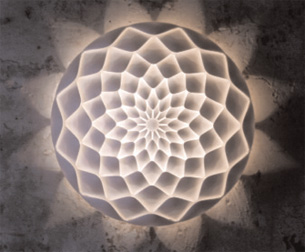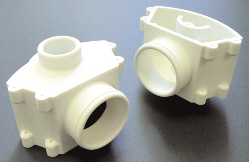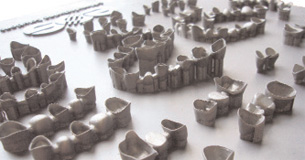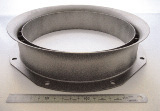Changing the Rules of Design for Manufacture
EOS laser-sintering technology helps a growing number of manufacturers extend their expertise into new areas of opportunity.
Latest News
August 1, 2008
By Anthony J. Lockwood
 Figure 1: The laser-sintered Dahlia wall sconce from Freedom of Design is based on Fibonaccisequence, which would be nearly impossible to make using subtractive manufacturing. Images courtesy of Freedom of Creation. |
Laser-sintering technology just naturally changes how you go about your business. It puts the design back into design-for-manufacture by enabling you to imagine, prototype, and build production parts with complex geometries previously unmanufacturable due to machining constraints, exorbitant costs, or both. Additive plastic or metal laser sintering complements your existing subtractive fabrication machines by extending your manufacturing expertise into new areas of opportunity — such as design for function, part consolidation, and mass customization — while simultaneously compressing process cycles.
Still, no matter what your industry (aerospace, consumer products, or even creative arts), differentiation is key to market acceptance. Yet product differentiation has always been subservient to the design rules of your manufacturing process. It is intrinsic to the nature of an additive manufacturing laser-sintering machine, however, to change the rules of design and manufacturing.
Innovation from Bottom Up & Inside Out
A system such as the EOSINT M 270 for DMLS (direct metal laser sintering) or P 730 for plastic laser sintering from EOS will fabricate almost any part you model because it builds parts layer by layer from the bottom up and the inside out. This frees you to design a part for its function with whatever complex external or internal geometry you need to achieve your goal. What’s more, you can explore innovative designs that not only meet customers’ needs but differentiate your products beyond customer expectations.
Freedom of Creation (FOC), judging by its online gallery, seems to know no expectation it cannot exceed. Based out of Amsterdam, FOC specializes in design and research for rapid manufacturing. Together with its manufacturing partner FKM Sintertechnik, a leading RP service bureau in Europe, FOC creates everything from fashion and home accessories to textiles and lighting systems all leveraging laser-sintering fabrication techniques.
FOC’s Dahlia wall/ceiling sconce, for example, would be a nightmare to manufacture as a single unit using traditional methods (see Figure 1, above). The design uses the mathematics of nature to create a 3D shape that, when viewed head on, looks something like a sea urchin. Except for mounting screws and lamp, Dahlia, made entirely of laser-sintered white polyamide finished to protect against dirt, measures 12.5 in. wide by 6.3 in. deep and weighs just 1.4 pounds.
 Figure 2: Paramount PDS made these air plenums for an aircraft manufacturer out of PA 2210 FR, a flame-retardant plastic for laser sintering. Image courtesy of Paramount. |
Design freedom also enables you to converge technologies in unexpected ways. A case in point is the AI Light from London designer Assa Ashuach with an assist from Complex Matters, a design and engineering firm with expertise in software. Leveraging mechatronics and an artificial intelligence (AI) engine, the AI Light interacts with its environment, changing its shape in response to movements, sounds, and light. Excluding sensors and electronics, AI Light is a one-piece laser-sintered unit.
Of course, exceeding expectations by differentiation is not the purview of the consumer products and arts worlds alone. Paramount PDS differentiated itself by using PA 2210 FR, a flame-retardant poly-amide from EOS, to make aircraft components. PA 2210 FR outperformed five alternative materials under FAR 25.853 specifications as well as UL 94 V-0 (flammability for aircraft burn, smoke, and toxicity) tests at an independent lab, and Paramount’s client, a luxury aircraft maker, has qualified and adopted laser sintering for custom flight hardware.
According to a Paramount spokesperson, laser sintering freed its engineers to design components in complex configurations for the form and function of aircraft applications (see Figure 2, left). The material is now used in more than a dozen laser-sintered aircraft components, all of which are designed for rapid manufacturing and are unmanufacturable by traditional methods. An added benefit is that laser sintering with PA 2210 FR has enabled Paramount’s client to slash production lead times and eliminate tooling costs.
 Figure 3: EOS developed this series of dental copings to demonstrate the ability of its direct metal laser-sintering systems to produce one-of-a-kind, mass-customized spare parts on demand for markets not generally thought of during discussions on rapid manufacturing. Image courtesy of EOS GmbH. |
This focus on function also opens up new opportunities in prototyping, mass customization, and on-demand spare parts since laser sintering can produce complex geometries, from fuel systems to dental copings, with properties and behavior optimized to the part’s function (see Figure 3, above). Steve Ettelson, general manager at Vaupell Rapid Solutions in Hudson, NH, sees laser sintering playing that role in investment castings with small, delicate cores. “We do a lot of aerospace foundry and medical device work,” says Ettelson. “There is no practical way to prototype these things. EOS gives us that shot.”
A Couple of Cool Attributes
Probably the least heralded attribute of direct metal laser sintering is its ability to optimize and reduce cooling cycles by creating molds with integrated and conformal cooling channels. Basically, laser sintering can turn a mold into a hot runner.
 Figure 4: A golf ball is the end product when all sections of this direct metal lasers intered blow mold using conformal cooling and integrated cooling vents are assembled.Image courtesy of Es-Tec, DemoCenter. |
Generally, optimized cooling means you use Abaqus or your bank of 20 years’ worth of trials and errors to analyze where to drill right-angled holes into your mold to ensure that coolant circulates as near to hot spots as possible while maintaining uniform thermal transfer from the cavity, materials, and mold to the coolant. Laser sintering, however, lets you design molds with built-in conformal cooling lines that are curved, spiraled, or shaped in whatever way to optimize cooling (see Figure 4, right).
You can even integrate localized cooling channels into tool inserts. For example, at least one manufacturer builds water pump housings with integrated cooling channels using EOS’s MaragingSteel MS1, a high-performance 18 maraging 300 steel.
Another advantage of laser sintering is that you can build parts with highly accurate yet very thin walls with relatively little mass of the sort that would be too cost-inefficient, time-consuming, or virtually impossible to cut with traditional subtractive machining. Such thin walls also provide a means to optimize strength with the least amount of material (see Figure 5, page 19).
Fewer and Higher-Quality Parts
Through its innate support of inside-to-outside fabrication, laser sintering lets you focus on the relationship between an assembly and its function rather than concentrating your design efforts on the interfaces — tolerancing, friction, fasteners, and so forth — among parts in an assembly. This freedom to design permits you to consolidate parts to build assemblies that are more complex yet have fewer moving or static part interfaces. This results in assemblies that are more robust and of higher quality, thus reducing maintenance, serviceability, and warranty costs.
Coupling freedom of design with the ability to build a single part of any form cost-effectively means that laser-sintering technology also makes mass customization a routine process. For example, Andreas Hettich, a maker of centrifuges that separate blood components, used an EOS P 380 plastic laser-sintering system to solve an ongoing problem in healthcare lab work — blood bags come in different sizes around the world.
One-size fit all centrifuge boxes for holding these bags hampered Hettich’s business efforts, and inventories of all possible variants was impractical. Designing for laser sintering let Hettich rethink its centrifuge box entirely, from the design itself through tooling and assembly. Parts consolidation allowed designers to integrate the box, drip tray, and fixturing into a single unit, eliminating several tools required for making each part as well as associated assembly steps. Perhaps more importantly, Hettich gained the ability to produce different versions of the newly optimized centrifuge box on-demand to satisfy constantly changing client requirements.
|
Back to the Roots
Design for function, parts consolidation, and conformal cooling will save time in your processes downstream, but quantifying hard savings figures is difficult because comparisons are situation-dependent. Still, it’s fair to say that engineering and manufacturing time garner the biggest savings. When asked about savings, Gregg Morris of Morris Technologies, a leading proponent of laser sintering, cites the example of a handle mold he worked on. Morris estimates that the handle, a single-cavity tool (with 5,000 shots required), would have consumed 14 days from engineering through polishing to complete. He did it in 8 days with laser-sintering fabrication — a time savings of 43 percent.
None of this means, however, that you should dump your subtractive machines. Simple parts are still best done using traditional methods, and the two technologies can work in harmony; e.g., you can machine a cavity and insert a geometrically complex laser-sintered core. When you are confronted with a choice between the two, laser sintering should be considered as a viable alternative to multiple machine setups, weeks of electrode design, or volumes too low to merit the expense.
Laser sintering returns design engineering to its roots by enabling you to design complex parts that serve their functions rather than kowtow to the physical constraints of a machine not designed to make them. Additive laser sintering changes the rules of design and manufacturing by enabling you to make almost any shape you can design, making product differentiation — and function — subservient to your ability to innovate.
More Info:
Dassault Systemes
Providence, RI
simulia.com
Assa Ashuach Design Studio
assaashuach.com
AI Light video
Complex Matters
London, UK
complexmatters.com
EOS of North America, Inc.
Novi, MI
eos.info
Freedom of Creation BV
Amsterdam, The Netherlands
freedomofcreation.com
FKM Sintertechnik GmbH
Biedenkopf, Germany
fkm-sintertechnik.de
Andreas Hettich GmbH & Co. KG
Tuttlingen, Germany
hettichlab.com
Materials Solutions
Birmingham, UK
materialssolutions.co.uk
Morris Technologies
Cincinnati, OH
morristech.com
Paramount PDS
Langhorne, PA
paramountpds.com
OASE
Corona, CA & Hoerstel, Germany
oase.ca
Vaupell Rapid Solutions
Hudson, NH
vaupell.com
Editor at Large Anthony J. Lockwood is the founding editor of Desktop Engineering. He’s now an independent freelance writer. Send e-mail about this article to [email protected].
Subscribe to our FREE magazine, FREE email newsletters or both!
Latest News
About the Author
Anthony J. Lockwood is Digital Engineering’s founding editor. He is now retired. Contact him via [email protected].
Follow DE






 Figure 5: This double-walled and vaned inlet duct built with an EOS M 270 DMLSmachine has an accuracy of 0.1mm. Image courtesy of Materials Solutions.
Figure 5: This double-walled and vaned inlet duct built with an EOS M 270 DMLSmachine has an accuracy of 0.1mm. Image courtesy of Materials Solutions.